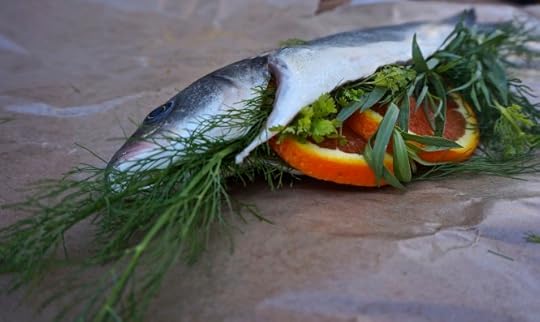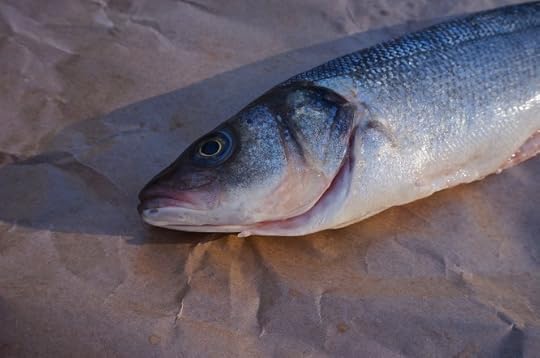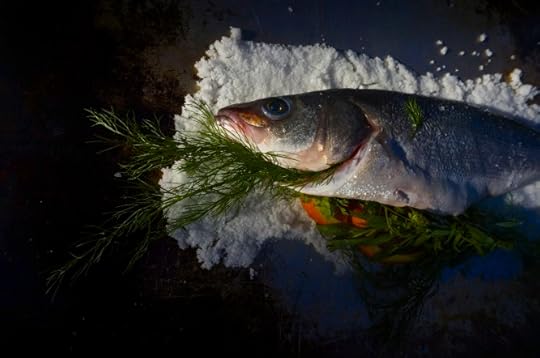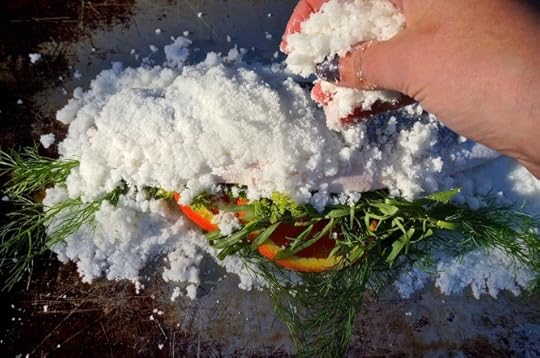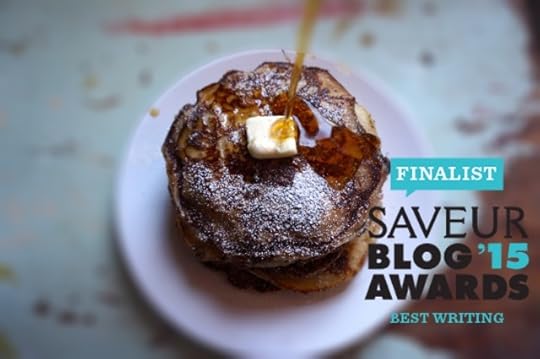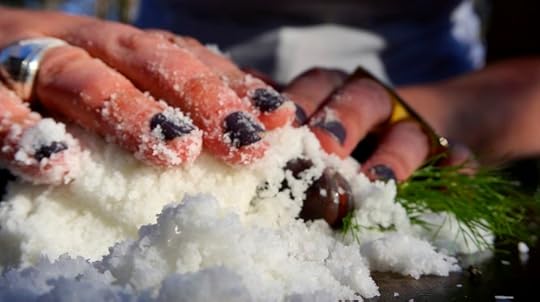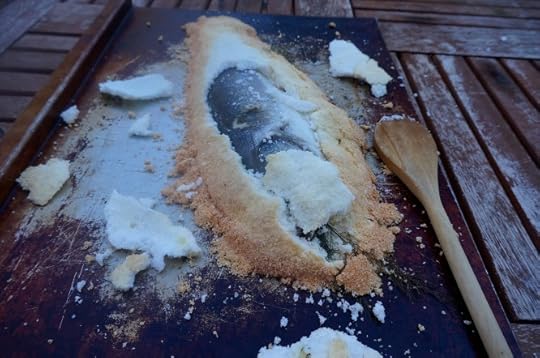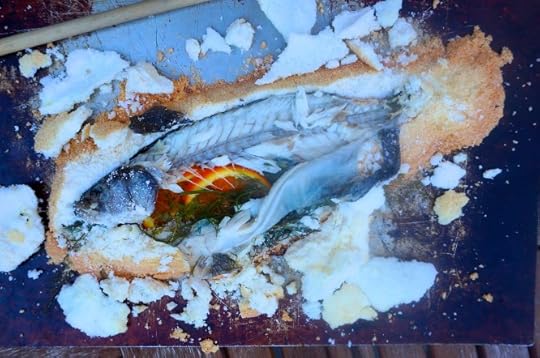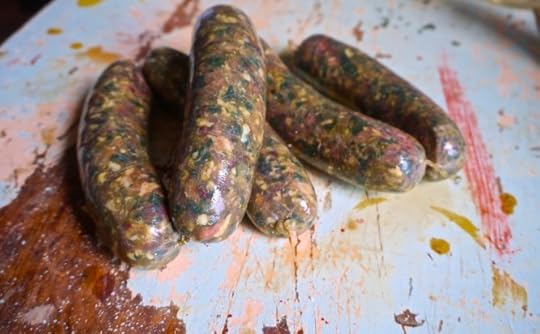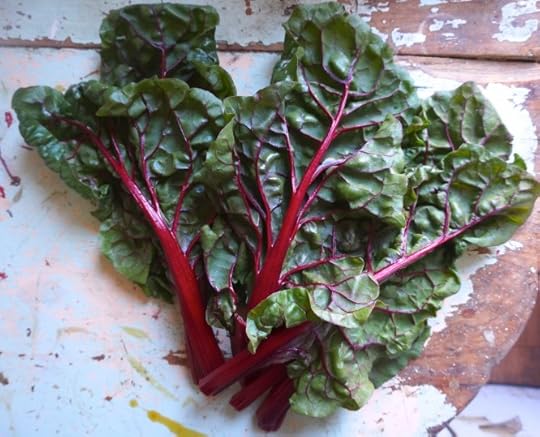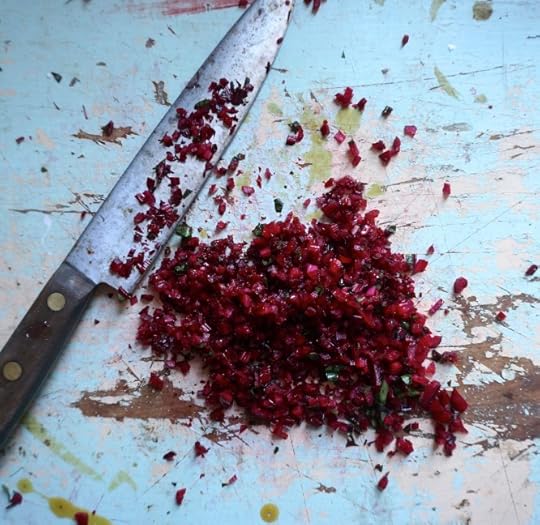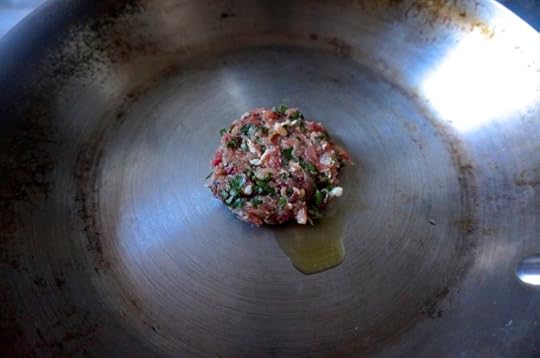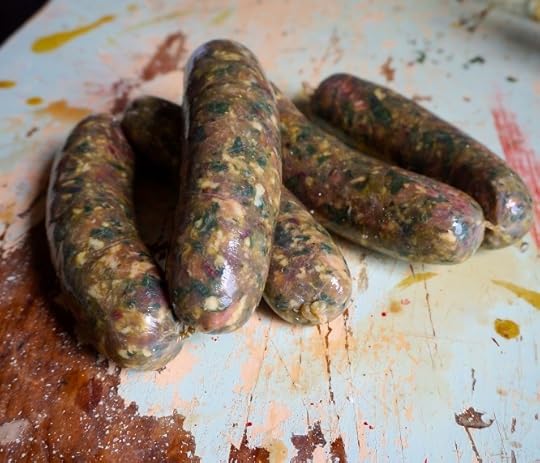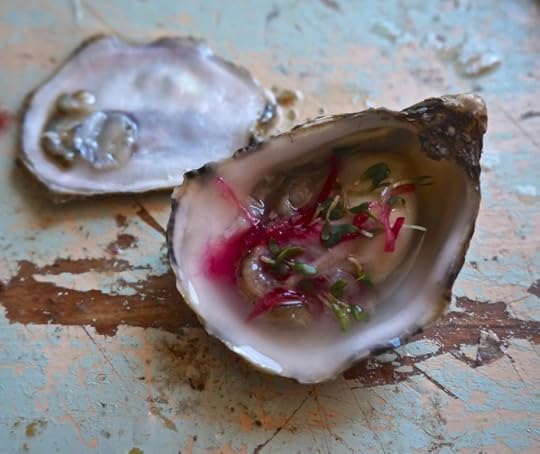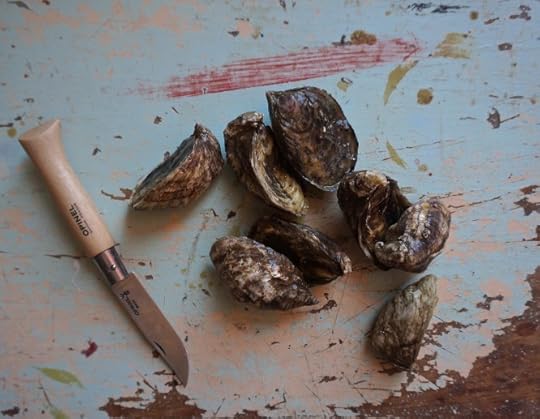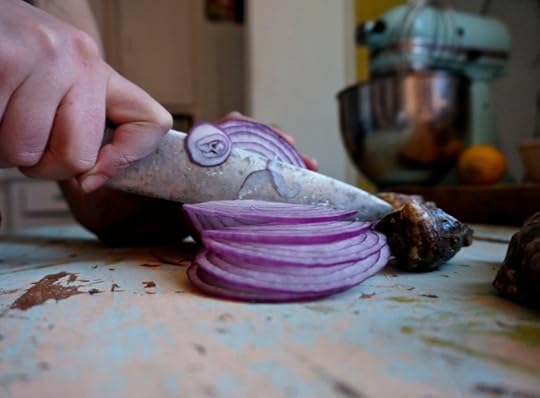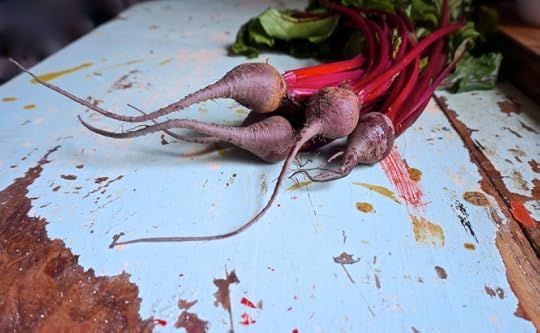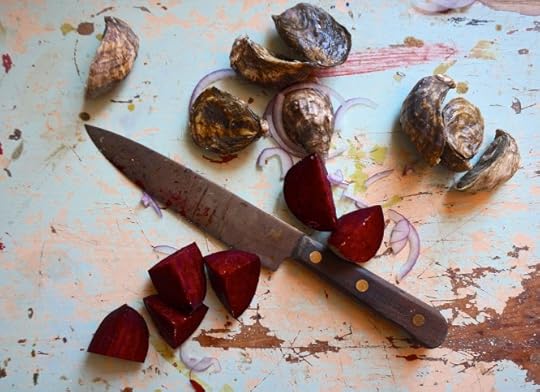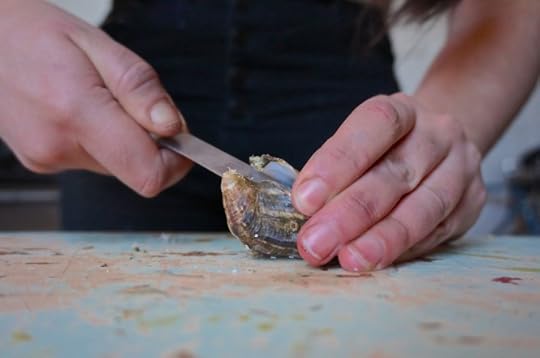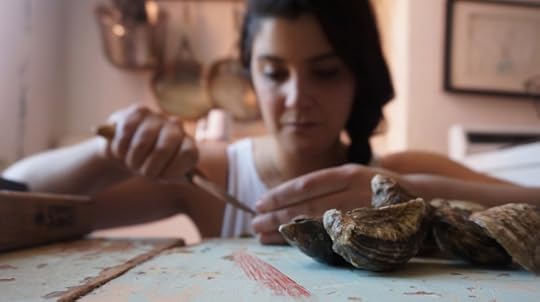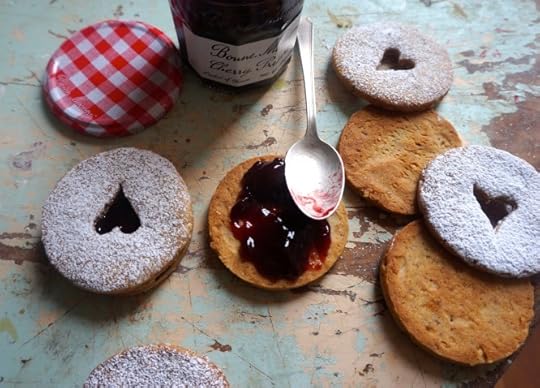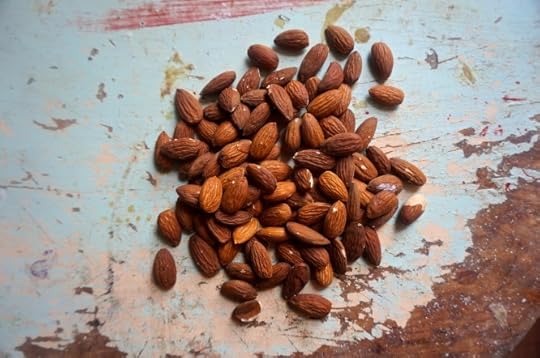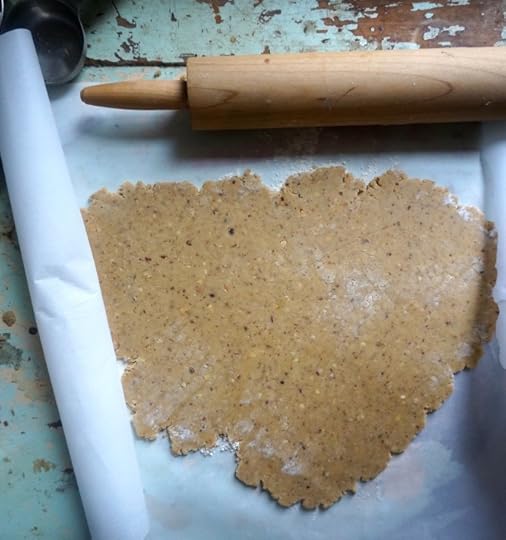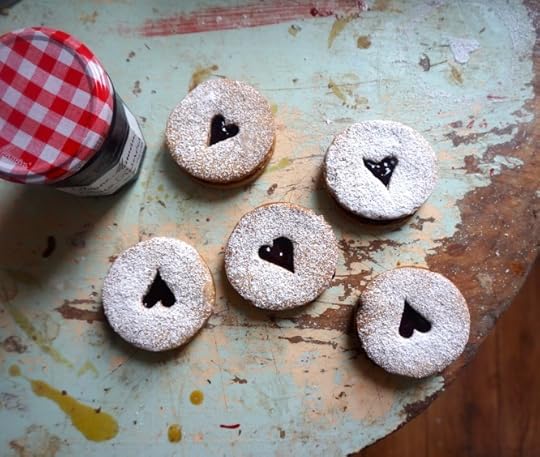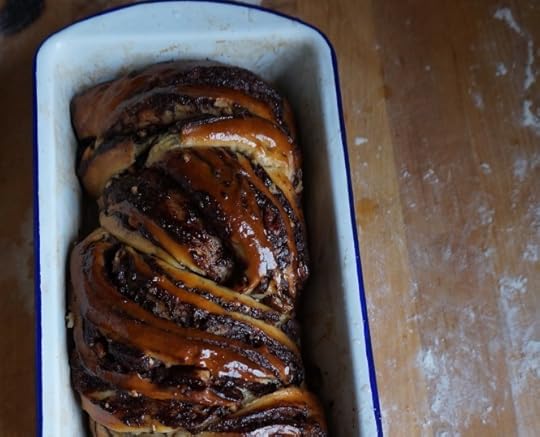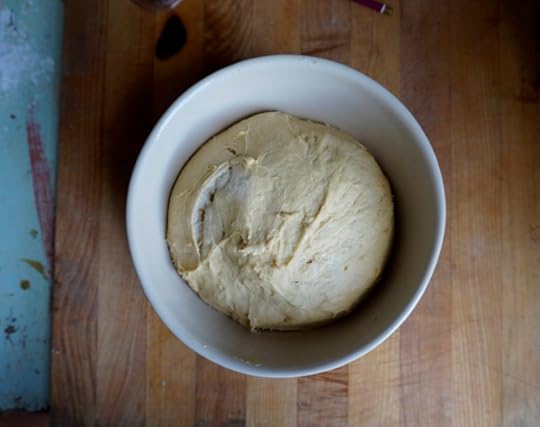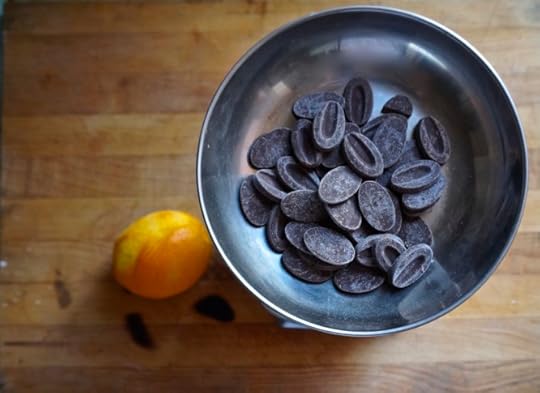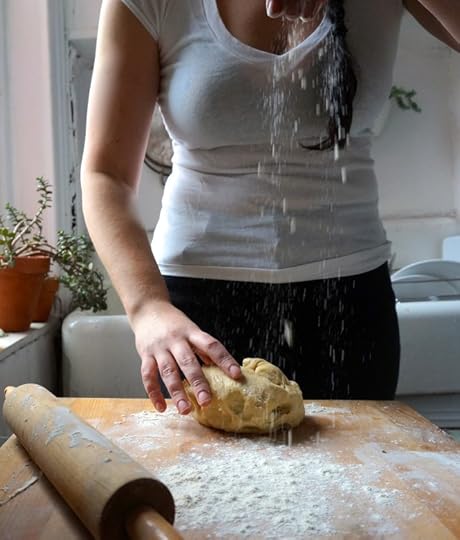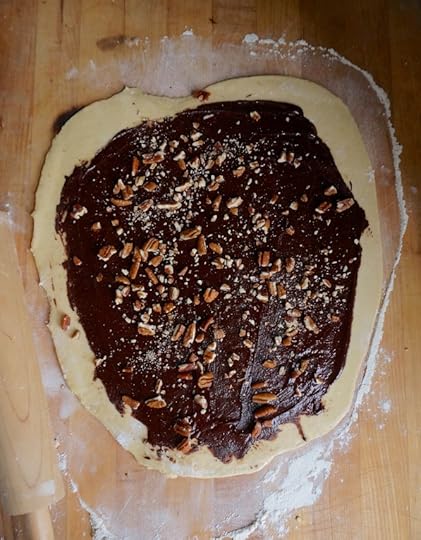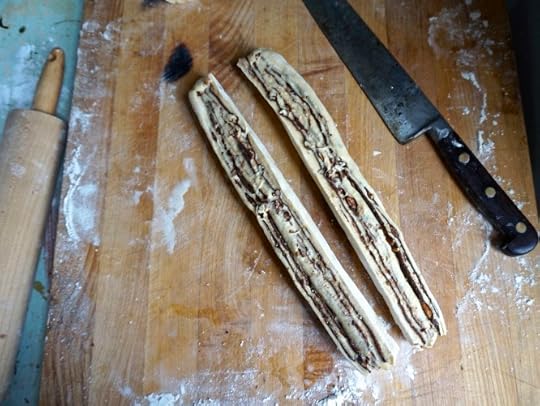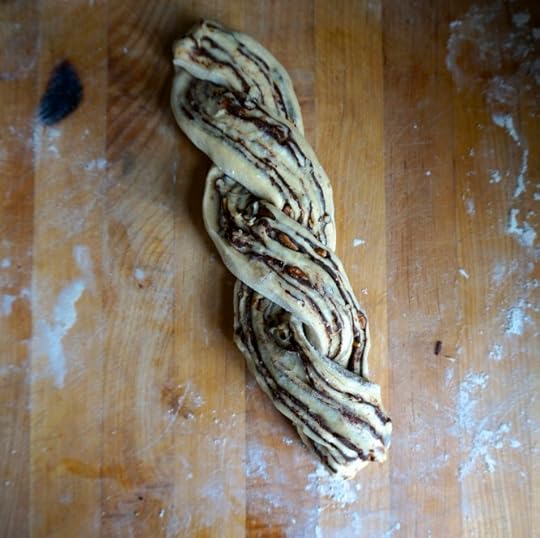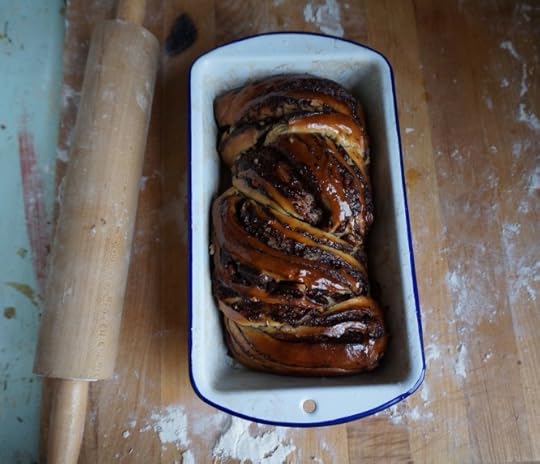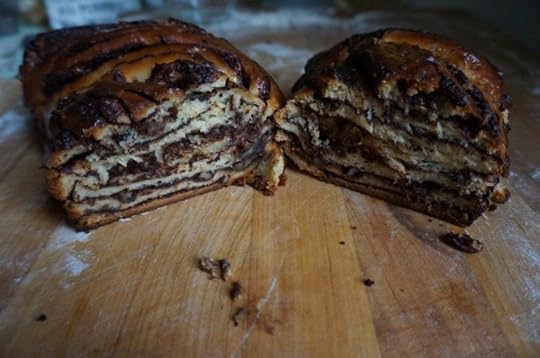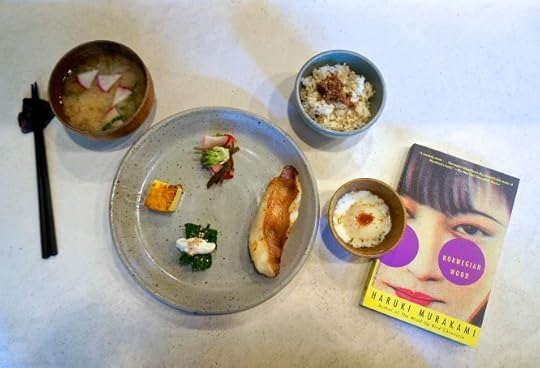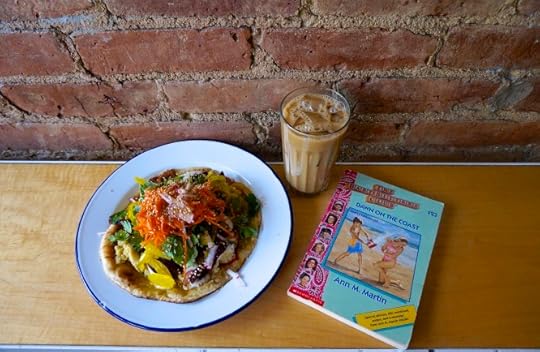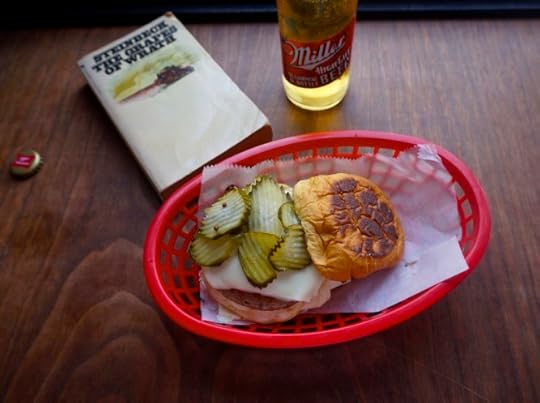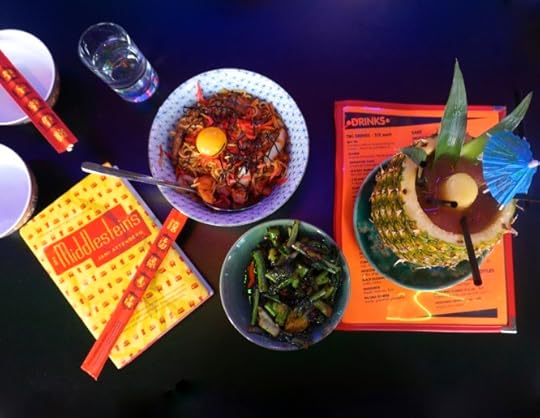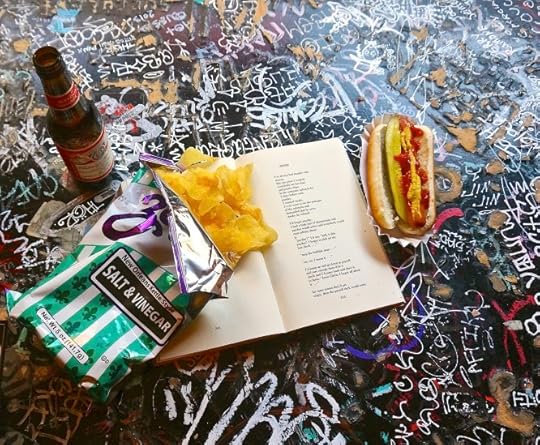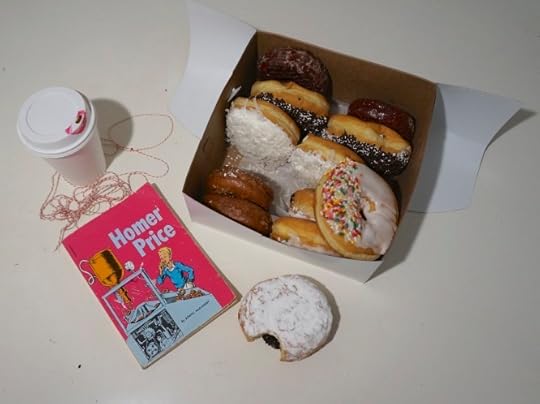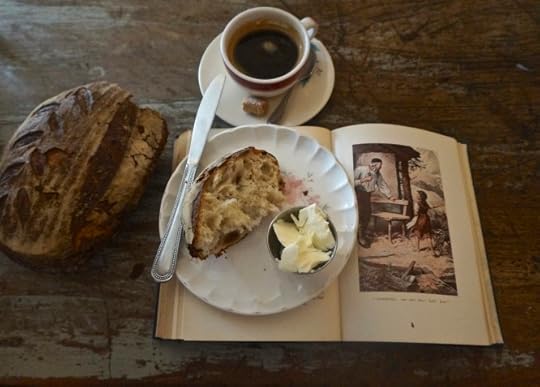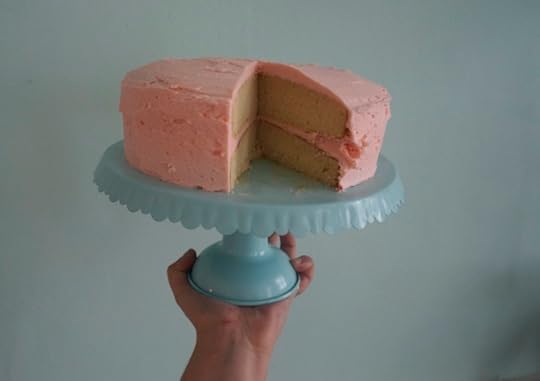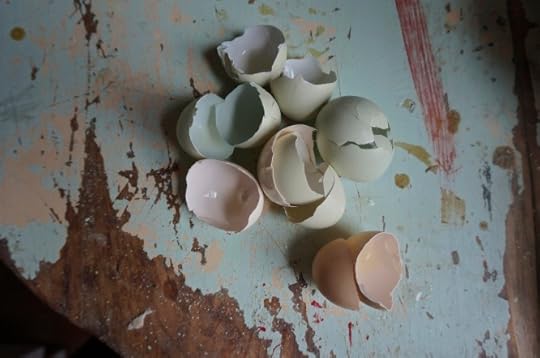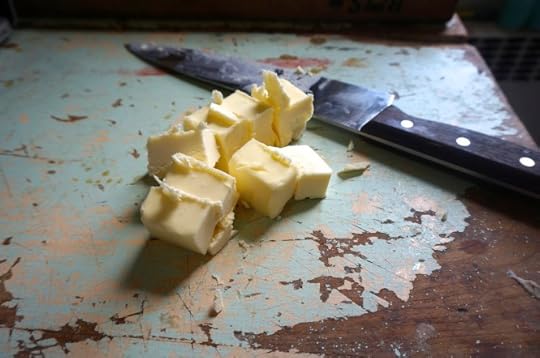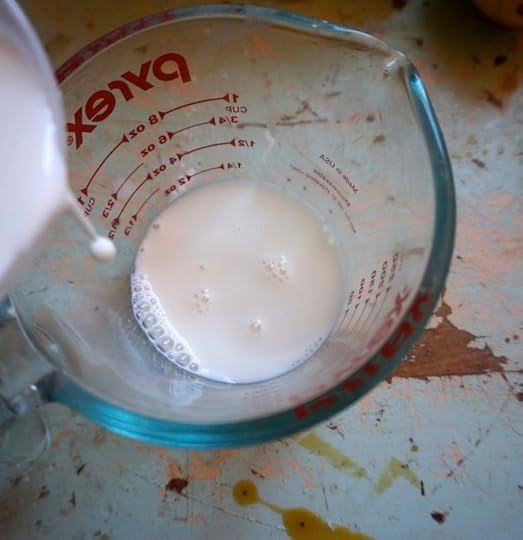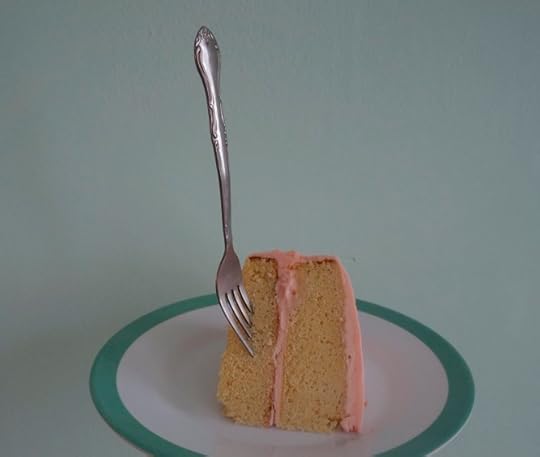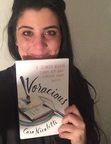Cara Nicoletti's Blog
October 1, 2015
Savannah Book Festival Event!
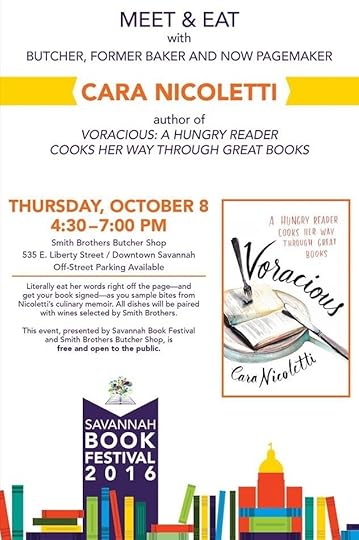
Friends! I’m sorry I’ve been away from this space. It’s been a long and exciting and tiring and exhilarating couple of months since Voracious came out. I’ve been away from my kitchen a lot, which has made keeping up with the blog difficult, but things are winding down and I’ve got lots of great stuff planned for you. On Wednesday I’ll be in Savannah, Georgia for the Savannah Book Festival and I would love to see you there! I’ll be doing a reading and signing at the iconic Smith Brothers Butcher Shop. There will be food from Voracious and lots of hot babes (I can’t promise this, actually, but I bet it’s true). Come! Bring your everyone!
Also, if you’ve bought the book and liked it, let the world know! I guess you can let the world know if you didn’t like it, too, but I’m not going to encourage it. Having a solid number of reviews and ratings behind a book helps first time authors like me. So, head to Amazon or Goodreads and write some reviews.
I like you all, I’ve had such a wonderful time meeting you this summer. More soon!
August 11, 2015
Voracious Events and Tour Info!
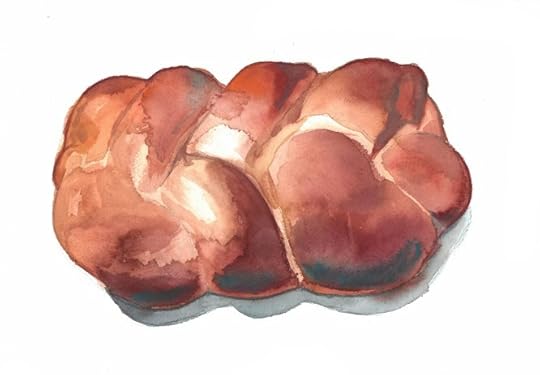
In exactly one week, Voracious will really be here! You will really see it in real book stores! This is just a quick update to remind you to get your pre-orders in (here! here! here!) and to fill out this sheet if you do pre-order so that we can get you some fun treats.
Also, here is a list of events that I hope to see your friendly faces at–I love friendly faces!
8/18 Fort Greene; Greenlight Books; 7:30pm
9/10 Brookline, MA; Brookline Booksmith| Talk and Book Signing; 7pm
9/11 Wellesley, MA; Wellesley Books| Talk and Book Signing; 7pm
9/14 Santa Rosa, CA; Book Passage| “Spinster Sisters Dinner with Writers” and book signing; 6pm
9/15 Napa, CA; Copperfield’s Books| Whole Foods Market Culinary Center; Presentation with food samples and book signing; 12noon
9/16 Beaverton, OR; Powells | Talk and Book Signing; 7pm
9/27 Baltimore, MD; Baltimore Book Festival; time tk
10/8 Savannah, GA; Smith Brothers Butcher Shop/ Talk and Book Signing; time tk
July 23, 2015
“Voracious” Sneak-Peek and Pre-Order Links!
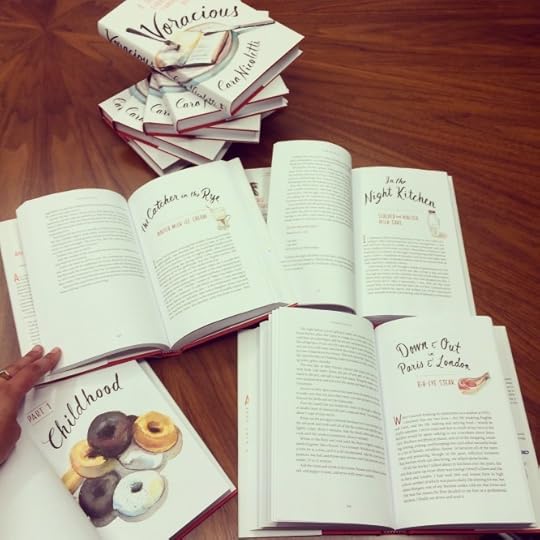
In less than a month (26 days to be exact, but who’s counting?) Voracious will actually be in bookstores. When I started this process–nearly three years ago!–I had a vision of what this time would feel like. At night, lying in bed after endless days of waking up before dawn to write, going into my job, and then getting home to write late into the night, I clung to the thought of this very time. I imagined excitement and pride, but most of all I imagined relief, calm. The excitement and pride are there, that is for sure, but the relief and the calm have yet to show themselves.
When I was a kid, before going to baseball games or birthday parties or away on vacations, I would get a terrible knot in my stomach that I was sure was anxiety. I wondered what was wrong with me that things so exciting could cause me such terror and dread. It took me until only a few years ago to realize that this gut-churning nervous anxiety was actually just excitement. Even now I have a hard time distinguishing between the two, which is kind of a sad thing to admit, but it’s true that there is a fine line between excitement and anxiety. I’m feeling both, I think. There is, of course, anxiety about thrusting such a huge part of myself out into the world and inviting people to scrutinize it, about how it will sell and how people from my past will feel about making an appearance in these pages. But the excitement, I think, outweighs it this time. I’m so excited to show you what a beautiful job Little, Brown did designing this book, and for you to see all of Marion’s incredible illustrations. I’m excited to know how you read the book–will you read it cover-to-cover or just read the essays about the books you have read? Mostly, I’m excited to engage with all of you about what books have shaped your lives, to know what pages pulled you through your own grapplings with loss and heartbreak and change.
In the meantime, while I pull my hair out waiting anxiously (excitedly!) for August 18th, here is a preview of what’s to come. Directly below are links to a few different places where you can pre-order the book. This means it will arrive at your door on August 18, and there will be a few fun little treats included as well as a reward for being an early-bird (fill out THIS form and you’ll get some temporary tattoos of Marion’s illustrations!). Below that you’ll find an essay from the first chapter of the book! There will be more updates to come, including book tour dates and locations and other event information, so stay tuned.
Barnes & Noble
Mcnally Jackson
Amazon
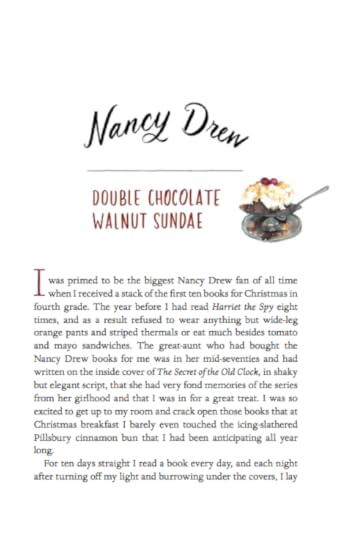
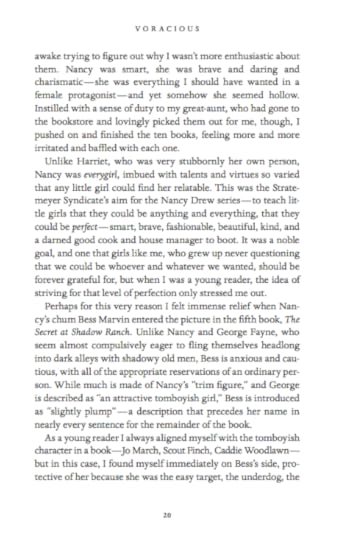
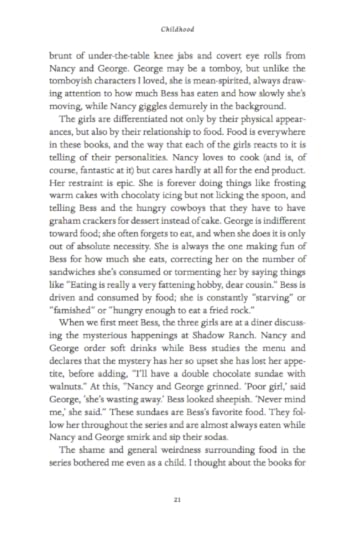
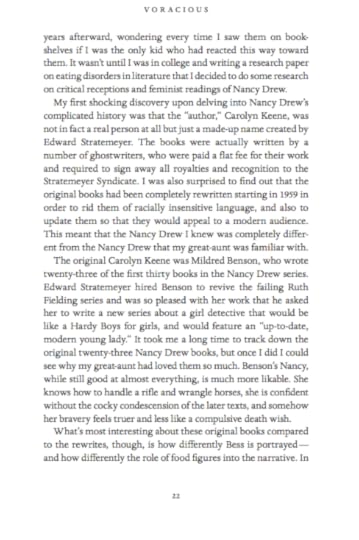
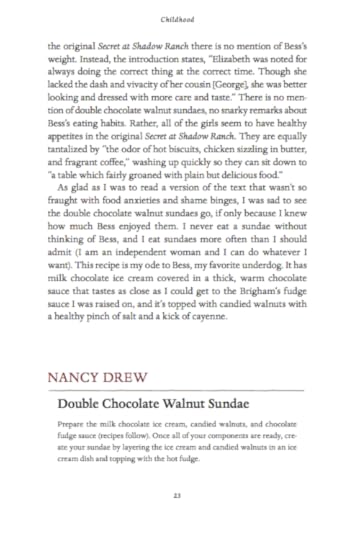
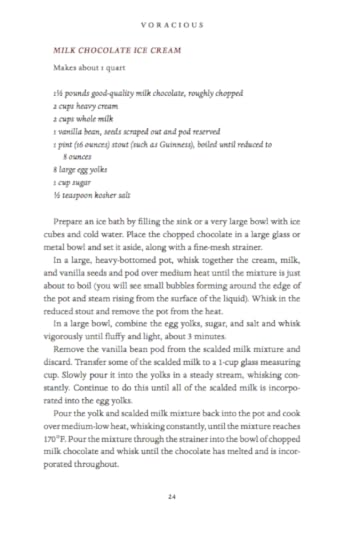
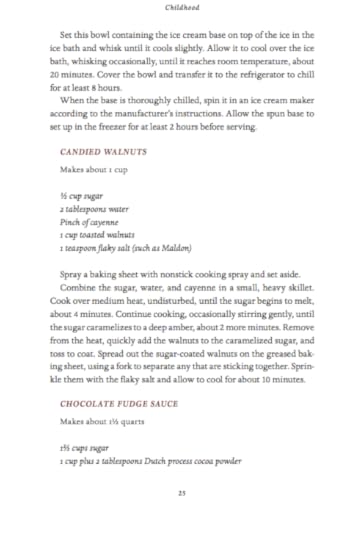
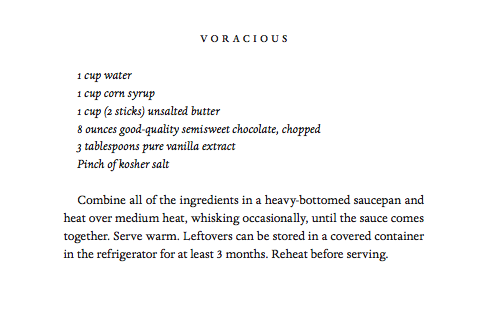
April 29, 2015
“Eating Fish Alone” Fennel & Orange Sea Bass
I was eighteen when I moved to New York, and I missed my family every time I sat down to eat: in dining halls with people I wasn’t sure I liked yet, in my apartment with the roommates I slept inches away from but barely knew. At home, eating was always communal. Even if we were eating pop tarts in the morning, we were eating them together, and at night we always gathered as a family for dinner. Here, in this new city, I wanted badly to feel at ease eating by myself because in my mind, this would mean that I was really living on my own as an adult. In high school, out of necessity, I mastered the art of going to movies by myself—something I still do happily and often—but eating something more substantial than popcorn, out in the daylight for all to see, was an entirely new hurdle. We’re taught early on to fear the prospect of eating alone—it is, after all, always the least popular kids who sit alone in the cafeteria. Type “dining alone” into Google and prepare yourself for pages and pages of solo-eating anxiety, including information on a café in Japan that seats lone diners with large stuffed animals to help them feel less awkward.
Not to get all “when I was a kid” on you, but during those first gut-churningly homesick days eleven years ago, there were no smartphones—I had a Nokia the size of my foot with a jewel-green plastic covering that didn’t even have texting capabilities. These days, it’s much easier to go out to dinner on your own—if the loneliness starts creeping in, you can always reach for your phone and text your friends, or scroll through and see what they’re up to on a thousand different social media platforms. It’s nearly impossible to feel completely alone. This sounds, in theory, like a positive thing, and certainly sometimes it is, but I am forever grateful that I came of age in a new city before that was an option—that I had so many moments of true, unrelenting, public solitude. That I let the loneliness wash over me completely and still came out on the other side.
Eating with someone, sharing a meal, is a deeply personal thing—we know this, of course. It’s the reason that eating scenes in literature are often so telling—who a person is eating with, how they are sharing the space of a dinner table, what is said between bites—these things matter more, somehow, because they’re happening over a meal. People who love to run might say that they are never more aware of themselves than when they are hearing their own hard, steady breaths, or their elevated pulse pounding in their ears, or smelling the scent of their own sweat. Eating is my meditation, the lens through which I see most clearly and know myself best—I am never more aware of my own self than when I am alone, listening to myself chew.
One of my favorite writers, Lydia Davis, devotes an entire essay, not just to eating alone, but to eating a specific food—fish—alone. “I am alone with sardines on white bread with mayonnaise and lettuce, I am alone with smoked salmon on buttered rye bread, or tuna fish and anchovies in a salade niçoise, or a canned salmon salad sandwich, or sometimes salmon cakes sautéed in butter.”
For Davis, eating alone in a restaurant is ritualistic, rife with habit.
“I bring a book with me, though often the light over the table is not very good for reading and I am too distracted to read. I try to choose a table with good light, then I order a glass of wine and take out my book. I always want my glass of wine immediately, and I am very impatient until it comes. When it comes, and I have taken my first sip, I put my book down beside my plate and consider the menu. My plan is always to order fish.”
Until I read this essay, I had never considered what my own rituals are surrounding solo restaurant eating, but it made me realize that I never ever order fish. I have no idea why this is. There is something lovely about sitting alone in front of a whole roasted fish. Rather than seeing one part of the whole—a salmon filet fried in butter, a fatted fluke liver, whisper-thin slices of crudo—you face your sustenance in its entirety, you are alone together.
On another note entirely, today is the last day to vote for yummybooks in the best writing category of the Saveur blog awards. I should have been pushing you all to vote for weeks, but something in me went silent and froze when I was nominated a month ago. I felt so touched and humbled by the nomination that it somehow made it impossible to write a word—does that make any sense? Probably not, but if you feel so inclined to send a vote my way you can click the image above or here to take you to the voting page. Thank you all for reading my words, I appreciate you more than you will ever know.
Fennel and Orange Salt-Baked Sea Bass
Serves 1 hungry person
Ingredients:
1 whole Mediterranean Sea Bass, 1-1 ½ pounds, gutted and scaled
½ a navel orange, cut into ¼ inch rounds
stems and fronds from ½ a fennel bulb
2 sprigs tarragon
2 sprigs dill
2 sprigs chervil
6 cups coarse kosher sea salt
4 egg whites
Directions:
Preheat oven to 400F. Stuff the cavity of the fish with the orange, fennel stems, tarragon, dill, and chervil.
In a medium bowl, mix salt and egg whites together with your hands until it resembles the texture of wet sand. Spread a 1-inch layer of the salt mixture on a baking sheet and lay the fish on top of it. Cover the fish with the rest of the salt mixture, packing it on to form a tight seal all around.
Bake the fish for 25 minutes.
Crack the salt crust with a wooden spoon to expose the fish. I just sat and ate it right off the pan, because that’s the kind of thing you can do when you’re alone, but if you want to be more civilized about it, please feel free.
March 26, 2015
“Hammer Head” Swiss Chard and Roasted Garlic Sausages
Nina is the first real writer I ever knew. I met her when I was just finishing high school, her little brother was my boyfriend, a boy who would become my first real grown-up love (and a man who remains one of the most important people in my life to this day). I was enamored of Nina, of her entire family—how they sat on their porch and drank beer after beer late into the night and still managed to talk so intelligently, to tell stories about books and love, to challenge each other. I remember going to Nina’s apartment in Cambridge and looking surreptitiously around her room, touching beaded necklaces and smelling books and perfumes, thinking, this is the stuff of a writer.
After many years writing my favorite blog on the entire Internet, Nina’s first book, Hammer Head: The Making of a Carpenter came out last week from W.W. Norton. At its simplest, Hammer Head is a memoir about Nina’s decision to leave her job at a newspaper and try her hand at becoming a carpenter. But, of course, it’s so much more than that. It’s a book about fucking up and trying again, about turning your entire life on its head and losing your mind in order to find peace. It’s about what it means to be a woman in a male-dominated trade, and what it means to be a woman, period. It’s about patience and anger and love and the terror and excitement of hoping that your life could be different—fuller—than you ever imagined.
It has always struck me as interesting that despite the difference in the paths we took, Nina and I ended up in roughly the same position—as writers whose day job involves working in traditionally male fields. On the most basic level our jobs are actually completely opposite. Her job is to build up, and mine is to break down. She starts with nothingness and ends up with somethingness. I start with a thing that is massive, whole, and end up with smaller parts that are themselves an entirely new thing. In the end, though, the goal is the same—we are both of us just the means to an end. Building a bookcase means envisioning someone plucking her favorite book from that very shelf and curling up, to build the frame of a house means picturing an entire life. For me, taking the entirety of an animal and breaking it into smaller parts—deboning and frenching and tying into roasts—always means imagining someone, or a family, eating. In one of my favorite passages, Nina talks about this metamorphosis, saying:
I put my palm down on a sanded-smooth plank of black walnut and I feel like vibration there, I see the galaxy-swirl grain, and I think of the tree that stood there to make this board, its roots veining deep into the soil, dark and warm, its long branches, its feather-shaped leaves in the wind, at sway and still. And here it is now, beneath my hand, joined, glued, clamped, turning into a table. A thing becoming other than it was.
“What was is now no more,” writes Ovid, “And what was not has come to be. Renewal is the lot of time.” We are all unfinished after all.
One of the great powers of reading is the way that books seem to find you at precisely the right time, and that is certainly true of this book. In the past couple of months, while undergoing a transformation of my own, I’ve read the book several times, and have been rereading certain passages in my darkest moments. This one in particular:
The jobs change. We go in and out of other people’s homes. A room becomes a different room, altered, with some of its essence intact. Loose tiles become a floor. Boards become shelves. Wood becomes a wall. Places change. Homes change. Weather changes. We change.
How do we decide what’s right for our own lives? The question never gets any easier to answer. If we’re lucky and we pay attention, pieces here and there will start to fit together. Parts shift into place, feel flush underneath the skin of the fingertip. For a moment, the bubble dips and shifts to show you level, at home with what you are, what you have become, and what you are becoming.
It seems fitting to me that in a book that has barely any food, sausages are mentioned several times in Hammer Head. Nina’s boss, Mary brings Tupperwares of sausages and white beans in tomato sauce to work, one of the electricians Nina works with raises pigs for slaughter and talks of the one-pound bags of sausage overtaking his house. And, after building him a bookcase, Nina’s father makes a big batch of thick sausage and white bean soup, warming the bowls with hot water before serving it to her. It feels fitting because sausage-making is one of the things I love most about working as a butcher—it’s the thing I gravitated to immediately when I started this work five years ago. Unlike the brute force, the ripping and tearing and popping that comes with most of whole-animal butchery, there is a finesse to sausage-making, a careful quietness that always brings me peace. And there is, too, the miracle of something becoming another thing entirely—of a pig becoming a pork shoulder becoming a sausage becoming a meal.
Roasted Garlic and Swiss Chard Sausage
Makes 2 pounds, or 5-6 links
Ingredients:
4 large garlic cloves
olive oil
5 large leaves Swiss Chard
2 pounds ground pork shoulder (should be about 70% lean to 30% fat), chilled
1 tablespoon kosher salt
½ teaspoon black pepper
zest of ½ lemon
¼ cup white wine, chilled
1 hog casing, rinsed (optional)
Directions:
Place garlic cloves in a very small pot and cover with just enough olive oil to submerge them. Cut a circle of parchment paper the size of the pot opening and cut an x in the middle of it. Place the parchment paper flush to the garlic cloves in the pot. Cook over medium-low heat until the cloves are deeply golden brown and fragrant—keep peeking under that paper, you don’t want them to burn! Strain the oil out (save it, it’s delicious for marinating meat or using in a salad dressing or just dipping bread in). Set the roasted garlic cloves aside to cool.
Separate the center stem from your chard leaves and mince both the stem and the leaves as finely as you can. Now take your cooled roasted garlic and mince that as finely as you can too (it should form almost a paste).
Place your chilled ground pork in the bowl of a mixer fitted with a paddle attachment. Turn the mixer to the lowest speed and add the salt, pepper, lemon zest, minced chard and roasted garlic. Mix for exactly 1 minute.
Add the chilled white wine and mix for exactly 1 more minute.
At this point, if you have a stuffer and you want to stuff and link the sausage, go for it! I’ve got some tips in this post and a video here to help you along. This sausage is really beautiful un-cased though, so don’t fret if you don’t have a stuffer. You can patty the sausage and eat it as a savory breakfast sausage with eggs, or crumble it into your pasta, or use it to make sausage and tomato and white beans like Mary or white bean soup like Nina’s dad.
Tonight is Nina’s book launch party at Housing Works Bookstore. She will be reading selections from the book, and I will be reading, along with Rosie Schaap (Drinking with Men), and Kate Bolick (Spinster). It’s free and the drinks are free and it will be a really, really fun time.
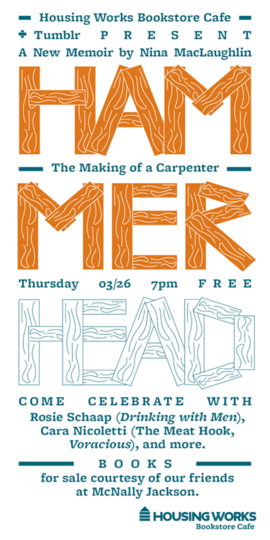
March 10, 2015
“Oysters” by Seamus Heaney
I’ve always been a nostalgic person—which is really just a much nicer way to say that I’m absolutely horrible with change. When I was in high school my grandparents changed the wallpaper in their kitchen from a brown and orange floral pattern to the same floral pattern in shades of gray, and I cried for a week (this is an exaggeration, of course, but not a huge one). Fear and avoidance of change has dictated the decisions I’ve made for most of my life. Certainly it has played an enormous role in where I am at this very moment—poised on the precipice of a sea change brought on by years and years of changing nothing. Isn’t that a lovely term? A sea change. If you happen to be afraid of change and terrified of the deep ocean like me, though, it’s not quite so lovely.
I’ve been a lot of things in my life, I’ve worked very hard, but I have never ever been brave. I mean that. Toughness and bravery are two very different things—I can say for sure that I am tough, but I am not brave. My only bravery is my willingness to tell you all that I’m afraid of this next chapter, that I’m up most nights afraid, and that I’m tired to my bones of being afraid.
When I was a kid and the clock struck midnight and New Year’s Eve turned into New Year’s Day, my sisters and I would run around touching things and eating things and making faces, declaring it the first time we’d done it that year! For me it was twofold, because my birthday falls on New Year’s Day—here is the first time I listen to this song or drink this drink or do this particular dance move as a ___ year-old. I still do it to this day, in my head at least, I’m sure a lot of you do the same. Lately I’ve been doing an opposite kind of meditation—here is the last time I make this walk, the last time my face is hovering over this particular vat of steaming chicken livers, the last time that one customer insists on telling me how tired I look and when I look in the mirror later I think “this is just my face,” before thinking that it doesn’t look quite like I remembered it to.
Two things keep running through my brain during this meditation, like a song that gets stuck in your head during a break-up. One is Joan Didion’s assertion that “it is distinctly possible to stay too long at the Fair.” It repeats over and over again in my brain while I’m drinking in that regular bar or trying to scrub that same corner of my kitchen that never ever gets clean.
Clips from Seamus Heaney’s poem “Oysters” have been running on a loop in my head, too–I think it was the thought of sea changes that put the poem in there. It’s a gorgeous poem, one of my favorites, have you read it?
Our shells clacked on the plates.
My tongue was a filling estuary,
My palate hung with starlight:
As I tasted the salty Pleiades
Orion dipped his foot into the water.
Alive and violated
They lay on their beds of ice:
Bivalves: the split bulb
And philandering sigh of ocean.
Millions of them ripped and shucked and scattered.
We had driven to the coast
Through flowers and limestone
And there we were, toasting friendship,
Laying down a perfect memory
In the cool thatch and crockery.
Over the Alps, packed deep in hay and snow,
The Romans hauled their oysters south to Rome:
I saw damp panniers disgorge
The frond-lipped, brine-stung
Glut of privilege
And was angry that my trust could not repose
In the clear light, like poetry or freedom
Leaning in from the sea. I ate the day
Deliberately, that its tang
Might quicken me all into verb, pure verb.
It’s those last words that gut me, and that have been rolling around and around lately—“I ate the day//Deliberately, that its tang//Might quicken me into verb, pure verb.” It’s a call for bravery, for action rather than thought, for a sea change.
Beet-Pickled Onions:
Ingredients:
1 small beet, scrubbed
¼ cup cider vinegar
¼ cup water
1 clove garlic, peeled and smashed
¾ teaspoons sugar
½ teaspoon whole black peppercorns
1 ¼ teaspoons kosher salt
½ a small red onion, cut into thin strips
2 dill sprigs
Directions:
Preheat oven to 450F. Wrap scrubbed beet in tinfoil and roast until fork-tender—about 40 mins.
Once the beet is tender, let it cool slightly. When it’s cool enough to hold but still warm, peel the outer skin off by rubbing it with a clean towel. Quarter the beet, set it aside.
In a medium saucepan, add your cider vinegar, water, garlic, sugar, black pepper and salt. Bring the brine to a boil, whisking occasionally to make sure sugar dissolves. Allow brine to cool 15 minutes.
In a sterilized pint jar, layer onions, dill sprigs, and beets. Fill jar with warm brine and let it sit, uncovered, for two hours. After two hours, cover and refrigerate until completely cooled. Shuck oysters and top with pickled onion and a splash of the pickle brine. Top with microgreens if you’re feeling aspirational.
February 14, 2015
“The Paying Guests” Linzer Tarts
Despite what some of my exes say, I have always loved Valentine’s Day. My grandpa sends me a box of Russell Stover chocolates in the mail and everyone talks out-loud about their feelings, which is a good thing to do every day of the year but we sometimes don’t. It doesn’t matter if you don’t have a romantic love in your life, you can celebrate any kind of love you want—the love you have for your car for example, which I just saw on My Strange Addiction (don’t watch it). Or you could celebrate the love you have for your friends, which in some ways is even more important than the love you have for your partner.
Right now I’m reading The Paying Guests by Sarah Waters. I have a feeling that something spooky is going to happen (don’t tell me!), but at this point, it’s mostly about a budding friendship between two women—Frances and Lilian—in London 1922. The first time Frances and Lilian spend the day together, they pack a picnic and head to the park. What each of the women pack speaks volumes about how different their personalities are.
They found a bench and unpacked their bags. And at once, it became apparent that they had had rather different ideas about what should constitute the picnic. Mrs. Barber had made finger-rolls, pin-wheel sandwiches, miniature jam tarts: the sort of fiddly dainties written about in the women’s magazines that Frances now and then read over her shoulders on the bus. She herself had brought hard-boiled eggs, radishes from the garden, salt in a twist of paper, half a round of seed cake and a bottle of sugarless tea, swaddled in a dish-cloth to keep it hot. But once they had set out the food on a chequered cloth, the meal looked surprisingly complete. ‘A perfect feast,’ they agreed, as they touched their cups together.
It pained me to not make toast with radishes and boiled eggs, but alas, these mini jam tarts seemed more Valentine’s Day appropriate. I hope you’ll make them for someone–anyone (or thing) you love. And if you really, really hate Valentine’s Day, try to remember this: tomorrow all of the good chocolate is 90% off at the pharmacy, so just sit tight.
Linzer Tarts
Makes 24
Ingredients:
2/3 cup raw, unsalted almonds
½ cup packed light brown sugar
2 ½ cups all purpose flour, plus more for dusting your parchment
½ teaspoon kosher salt
½ teaspoon baking powder
¼ teaspoon cinnamon
1 teaspoon vanilla extract
1 large egg
2 sticks unsalted butter, softened
2 tablespoons confectioner’s sugar
12 ounces seedless jam of your choice (raspberry is classic, I used cherry because I can’t be tamed)
First, toast your almonds. Set your oven to 350F and lay them out on a baking sheet. Toast them for 8-10 minutes, tossing them occasionally, until they are fragrant. Set them aside to cool.
Once the almonds have cooled, pulse them in a food processor with ¼ cup of the brown sugar, until the almonds are finely ground (some small chunks are good for texture)
Sift or whisk flour, salt, baking powder, and cinnamon together in a medium bowl and set aside.
In a separate bowl, add egg and vanilla together.
Add butter to the bowl of a mixer fitted with a paddle attachment and beat until smooth. Add remaining ¼ cup of brown sugar and beat at medium speed until light and fluffy—about 3 minutes.
With the mixer still running, add the egg and vanilla and beat until combined.
Reduce the mixer speed to low and slowly add the flour mixture and the almond mixture, mixing until they are just combined (be careful not to overmix).
Split the dough into two even chunks and wrap them in plastic, flattening them into disks. Refrigerate 2-3 hours, or until they are firm.
After 2-3 hours, pre-heat your oven to 350F.
Remove one of the disks from the fridge and place it between two pieces of lightly floured parchment paper.
Using a rolling pin, roll the dough to 1/8” thickness.
Cut cookies using a 2” circle-cutter and punch out a center hole in half of them using a ¾ inch circle cutter. Reroll and cut whatever scraps you have left.
Place cookies on a sheet tray lined with parchment paper, spacing them about 1” apart and bake, rotating the sheet pan halfway through about 10-12 minutes, or until the cookies are lightly golden-brown.
Transfer to a wire rack to cool completely.
Dust the top cookies (the ones with the holes in them) with confectioners’ sugar. Spread about 1 teaspoon of jam on the bottom cookies, and place the sugared cookies on top.
January 6, 2015
“Unorthodox” Chocolate Babka
I’ve never cared very much about birthdays. I have an epically bad one—New Year’s Day—which means that everyone is always too exhausted and hungover to do much celebrating. Either that, or everyone has started in earnest with their resolutions and no one wants to eat cake and mashed potatoes or drink champagne (for at least another couple of days). The last few weeks though, I found myself caring a lot about my birthday—stressing and dreading it in a way that was unfamiliar to me—the mere mention of it sending me into a sweaty anxiety spiral. I feel easy about the number 28, it’s a good, solid, round number. 29 I do not like. 29 feels like clinging to something that just isn’t there anymore, and it’s okay that isn’t there anymore—can we just skip to a clean, even 30 and be done with it?
This past year—my 28th—was major, the most important of my life thus far. First and most importantly, in March, my beautiful niece, Vivian, the first baby in our family, was born, and it changed my entire world in a way that I can’t even put into words. In April, I made lard biscuits and wondered about the future of butchery for Vice, and I also started writing a weekly column about meat for Food52, which has been challenging and exciting and stressful in a way that I badly needed. In July, I shot a commercial for Stella Artois with my amazing grandfather, Seymour, and we talked about butchery and drank beer and ate steak and he told me stories that I had never heard before. In September, my best friend, Emily—the reason that I stayed in New York, the reason I started this blog, the reason that I am where I’m at in so many ways—moved away from her little Manhattan Avenue apartment down the street from me and back to Portland, Oregon.
And there were all the months that I sat in a small, windowless room in my freezing cold apartment and I didn’t speak aloud to anyone for days at a time except sometimes to say “debit” to the woman at the grocery store which came out sounding like sandpaper because I hadn’t used my vocal chords in so long, and I wrote a book, a real life actual book, and it’s done (!), and it will be in real life actual book stores on August 18th, which feels like a century from now but it isn’t.
There was sadness and fear and loss in my 28th year, and there were failures too, many, as there often are. One of my biggest failures was keeping up with all of you in this space here. Having hard deadlines for the first time since college meant having to cut back on anything that didn’t have a deadline. It also meant that there was significantly less time for reading, which is an integral part of the upkeep of this space. For this reason, one of the things that I was most thankful for this year was the book club that Emily started before she moved away. It kept me reading even when I didn’t have time, and more importantly, it connected me to the coolest, smartest, funniest group of women I have ever known.
At our last book club meeting of 2014, which was right before Hanukkah, we made latkes and jelly donuts and drank cheap champagne, and we talked about Deborah Feldman’s memoir, Unorthodox, which details her decision to leave the strict Satmar sect of Hasidic Judaism that she was raised in. The book takes place in Williamsburg, Brooklyn, the very neighborhood that I live in, and reveals much about a population of people that I’m surrounded by daily, but know little about. The book is scandalous and fascinating, but devastating enough that I often found it hard to read.
In the midst of all of Feldman’s suffering, there are a handful of shining, happy moments from her childhood that make her pain slightly easier to bear, and usually these moments involve food. Her bubby’s kitchen is “like the center of the world,” it is where people congregate to chatter and gossip, where all good news is shared. “It is in this kitchen,” Feldman writes, “that I have always felt safe. From what, I cannot articulate, except to say that in the kitchen I did not feel that familiar sense of being lost in a strange land, where no one knew who I was or what language I spoke. In the kitchen I felt like I had reached the place from which I came, and I never wanted to be pulled back into the chaos again.”
Of all the myriad things I could not even begin to wrap my head around in the book, this I fully understand.
Happy 2015 to you, may it be filled with all the warm, chocolately bread you desire.
Unorthodox Chocolate Babka
Adapted from Smitten Kitchen
Makes 2 loaves
Ingredients:
4 ¼ cups all-purpose flour, plus extra for dusting
½ cup sugar
2 teaspoons rapid rise yeast
zest of ½ a navel orange
3 large eggs
½ cup water (may need up to 2 tablespoons more)
1 teaspoon kosher salt
2/3 cup (11 tablespoons + 1 teaspoon) unsalted butter, room temperature
neutral oil (I used vegetable) for greasing pan
Filling
5 ounces dark chocolate (about 1 cup chocolate chips)
½ cup (1 stick) unsalted butter
scant ½ cup powdered sugar
1/3 cup cocoa powder
¼ teaspoon cinnamon
1 cup toasted pecans, roughly chopped
Syrup
1/3 cup water
6 tablespoons sugar
Make the Dough:
In the bowl of a stand mixer fitted with a dough hook, combine the flour, sugar, yeast, and zest, eggs, and ½ cup of water. Mix on low until it comes together (this could take a couple of minutes). The ½ cup of water should be enough for the dough to come together, but if it doesn’t, add extra water 1 tablespoon at a time until it does.
With the mixer still running on low, add the salt and the butter, a little at a time, until it’s incorporated into the dough.
Turn the mixer speed up to medium and beat, scraping down the sides if necessary, until the dough is completely smooth and pulling away from the sides of the bowl—about 10 minutes.
Transfer dough to a well-oiled bowl, cover and refrigerate at least 8 and ideally 12 hours. NOTE: this dough doesn’t fully double and that’s fine.
Make the filling: In a small saucepan, melt butter and chocolate together over medium-low heat, whisking until smooth. Whisk in powdered sugar, cocoa, and cinnamon.
Assemble:
Butter or oil two 9×4 loaf pans. Line the bottom of the pans with parchment and butter or oil the parchment. Take half of the dough from the fridge and roll it out on a well-floured surface until it’s roughly 10 x 10. Spread half of the chocolate mixture evenly over the dough, leaving a ½-inch border all the way around. Sprinkle half of the toasted pecans over the chocolate. Carefully roll the dough up into a tight cylinder and trim about ½ an inch off each end and seal them. Place the dough on a floured baking sheet and freeze for 10 minutes (this makes slicing the dough in half much easier). Repeat this process with the remaining dough.
Remove the dough from the freezer and transfer it to a cutting board. Cut the dough cleanly in half lengthwise and lay the two halves next to each other, cut-side up. Pinch the tops of each side together and cross the two loves over each other into a twist shape. Place the twist in the loaf pan, curving it into an S-shape to fit in the pan, cut-side up. (You can take the ends that you trimmed off and tuck them into the blank spaces in the pan, or you can take all four ends and bake the in a small cake pan like cinnamon buns)
Cover the loaf pan with a damp towel and let the dough rise in a warm place for 1 ½-2 hours. Repeat this process with the second loaf.
Preheat your oven to 375F and uncover the loaves. Place loaves in the center rack of the oven and bake for 30-40 minutes or until a skewer inserted into the center comes out with no resistance—if it’s not cooked all the way, the center will feel rubbery and the skewer may come out with dough on it.
While the babka is cooking, make the syrup: whisk sugar and water together in a saucepan over medium heat until the sugar is completely dissolved.
As soon as the babka comes out of the oven, brush the syrup all over the loaves—it will seem like a lot but it will all sink in. Allow the bread to cool for about 30 minutes in the pan before turning it out onto a cooling rack and cooling completely. Or, if you’re like me, just eat it all right away and burn your tongue in a good way.
November 18, 2014
Brooklyn Restaurant & Book Pairings
Recently, I took a series of photographs pairing my favorite neighborhood restaurants with books for Opening Ceremony. I wanted to share those photos with you all here!
Okonomi, with a side of Norwegian Wood by Haruki Murakami
Haruki Murakami writes about food a lot in his novels and short stories, but the food scenes in Norwegian Wood are my favorite because of their clean simplicity. At one point the narrator eats a breakfast of “rice, miso soup, pickled vegetables, and fried eggs,” and at another point “eggs, mackerel, fresh greens, eggplant, mushrooms, radishes, and sesame seeds, all done in the delicate Kyoto style.” I had never had a traditional Japanese breakfast until Okonomi opened up down the street a few months ago. Every morning there is a prefix menu, the only choice you get is what fish you want, and all the fish comes in fresh every morning. Along with the fish, there are steamed greens with sesame seeds and tofu, pickled vegetables, a small square of egg custard, rice with bonito flakes, and a poached egg, barley tea, and the best miso soup I’ve ever had. I always leave Okonomi feeling somehow cleansed—not my usual feeling after going out to breakfast.
150 Ainslie Street
Brooklyn, NY 11211
MAP
Saltie, with a side of The Babysitters Club: Dawn on the Coast by Ann M. Martin
I had never even heard of sprouts or hummus until I read The Babysitters Club books in third grade. I don’t have much to thank them for besides that. Baby-sitter Dawn is a California hippie and totally disgusted by the eating habits of her friends in Stoneybrook, PA. The Clean Slate sandwich from Saltie is the California flower child sandwich of Dawn Schafer’s dreams. It has hummus and bulgur wheat, loads of pickled vegetables and fresh herbs, sesame seeds, and yogurt—all on house-made naan. I could eat it every day of the week (but don’t tell Meat Hook Sandwich).
378 Metropolitan Avenue
Brooklyn, NY 11211
MAP
Meat Hook Sandwich, with a side of The Grapes of Wrath by John Steinbeck
There’s a scene in John Steinbeck’s The Grapes of Wrath where a group of hungry children are standing around watching a tractor driver eat a spam and cheese and pickle and mustard sandwich. Generally this wouldn’t sound very appetizing, but because the kids are so hungry, it looks like the best meal in the world to them. Steinbeck’s language is so rich that you can taste and smell the sandwich just reading about it, and it makes you want one too. Meat Hook Sandwich doesn’t offer Spam (yet), but it does make a fried bologna sandwich with mustard and pickles and cheese, which is pretty darn close—and insanely delicious. We make the bologna in house at The Meat Hook and send it over to the sandwich shop, but I swear I’m not being biased about how good it is.
495 Lorimer Street
Brooklyn, NY 11211
MAP
King Noodle with a side of The Middlesteins by Jami Attenberg
The Middlesteins is a novel about a family dealing with eating disorders in all of its myriad forms. In one particularly poignant scene, Edie, a middle-aged woman who is literally eating herself to death, drives her daughter far outside of town to a neon-lit Chinese food restaurant called The Golden Unicorn. The restaurant looks unremarkable, but the food is incredible—“steaming, plush pork buns, and bright green broccoli in thick lobster sauce, sticky brown noodles paired with sweet shrimp and glazed chicken, briny, chewy clams swimming in a subtle black-bean gravy.” The restaurant reminds me of King Noodle, which from the looks of it, you might not think makes food as seriously good as it does (there is a disco ball and mirrored walls and a lot of neon). The wavy noodles with shrimp and pork and the Chinese broccoli are consistently perfect, and it always has really thoughtful specials. Plus, its cocktails are dangerously good and sometimes come in a frozen pineapple.
1045 Flushing Avenue
Brooklyn, NY 11237
MAP
The Second Chance Saloon, with a side of $$$$$$ by Bukowski
I hate Bukowski, but the love that I have for The Second Chance Saloon is real, and somehow the two just work together. There is plenty of beer drinking at dark bars in his collection of poems, “Love is a Dog from Hell,” but one poem in particular, called “$$$$$$” makes me think about The Second Chance. In the poem, Bukowski talks about being terrible at managing his money, and how in the days before payday he always had to eat chips and hot dogs because they were all he could afford. It seems like everyone who goes to The Second Chance is a regular and a great storyteller, and most of the patrons are bartenders or restaurant workers or bike messengers. It’s a place that I think Bukowski would have liked to hang out; it’s got a lot of heart. And it also happens to serve potato chips and hot dogs.
659 Grand Street
Brooklyn, NY 11211
MAP
Peter Pan Donuts, with a side of Homer Price by Robert McCloskey
After reading the story “The Donuts” in Robert McCloskey’s Homer Price as a kid, it has always been a secret dream of mine to own a donut shop. Peter Pan Donuts looks like it was plucked right from one of McCloskey’s pencil-sketch drawings, down to the stools at the counter. Donuts have definitely been having a moment the past few years, but in my opinion, nobody can touch Peter Pan—I live and die by its sour-cream old fashioned. (side note: there will be a recipe for old fashioned sour cream donuts in my book that get as close to Peter Pan’s as I could get them).
727 Manhattan Avenue
Brooklyn, NY 11222
MAP
Bakeri with a side of Heidi by Johanna Spyri
I read Heidi as a little kid and I think I can blame it for the bread addiction I still struggle with as a 28-year-old. Bread is mentioned something like 52 times in the book, which is about a little girl who lives with her grandfather in the Swiss Alps. The book is full of beautiful, simple meals, but they mostly eat bread with butter or goat’s milk cheese and a cup of coffee, which to me is a perfect meal. Nobody in the neighborhood makes bread as good as Bakeri. Its bread and pastries are baked in house every morning—the sourdough rye is my favorite. I have eaten a whole loaf in one sitting. Plus the space is beautiful and it makes really good coffee.
150 Wythe Avenue
Brooklyn, NY 11211
MAP
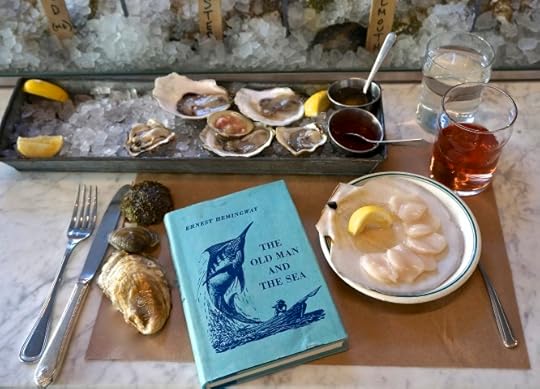
Greenpoint Fish & Lobster co., with a side of The Old Man And The Sea by Ernest Hemingway
When it comes to Hemingway, I’m more of a fan of his short stories than his novels, but I have a soft spot for The Old Man and the Sea. Growing up in Massachusetts so close to the ocean, I have an affinity for stories about fishermen and ship captains. At Greenpoint Fish, the fish is sustainably caught and comes in fresh every morning—the guys at the counter can tell you everything about where it was caught and even by whom. Besides having a great selection of seafood to take home and cook yourself, it also has an amazing raw bar and kitchen. Its lobster roll is the closest to a Massachusetts lobster roll I’ve had, and the fish tacos and chowder are amazing too.
114 Nassau Avenue
Brooklyn, NY 11222
MAP
November 11, 2014
“The Edible Woman” Lemon Cake with Lemon Buttercream
It seems like everyone has been talking about feminism lately. Let’s do a quick recap.
There was Beyonce at the VMAs declaring herself a feminist during her set. Then, there was Annie Lennox criticizing that declaration. There was Emma Watson’s “HeForShe” speech for the UN, and then the backlash of that speech. Roxane Gay wrote a New York Times Bestseller called Bad Feminist and expressed her disinterest in making feminism more palatable, and Jenny Slate said “Fuck yeah,” when asked if she was a feminist. Thinking people the world over shed a frustrated tear over the woefully misguided “Women Against Feminism” tumblr, and then tried to forget it existed.
The personal iCloud accounts of dozens of female celebrities got hacked and their private (nude) photos were leaked everywhere on the internet. Rag magazines rejoiced, splashing censored versions of the leaked pictures on every cover next to words like “ruined” and “shame,” despite the fact that these women had done nothing wrong. This lead to lots of discussions about consent and sex crimes and the female body as a commodity. Then Lena Dunham ran a campaign called “Women are Watching” for Planned Parenthood and wrote a memoir called Not That Kind of Girl and was being called things like “the feminist voice of a generation,” until people read the memoir and decided she was no longer worthy of that label (and then some).
Let’s recap this recap:
-Beyonce is a feminist
-Annie Lenox is a feminist and Beyonce is not
-Emma Watson is a feminist and so is Jennifer Lawrence
-unless you talk to Roxane Gay who is one and says they are not
-Tumblr is a terrifying place
-Jenny Slate is queen
-Lena Dunham is a feminist
-Lena Dunham is not a feminist and hates women (and then some)
It’s very very rare that I read a discussion about feminism in any form and feel angry or slighted –my dominant feeling is almost always gratefulness that the discussion is taking place at all. And then the other day I stumbled across a press bit about a new magazine called “Render” that is branding itself as a “Feminist Food & Culture Quarterly,” and I felt a new feeling. According to Render Magazine, “Food is a feminist issue.” The magazine is run by a group of people with degrees in feminism and gender and women’s and food studies, but only one of these people works in the food industry. In her bio, one woman says outright that she “doesn’t know much about food,” while another states that she is “bad at cooking but good at watching Chopped.” And yet, the magazine’s mission is “to empower women in the kitchen by representing women and their contributions to food culture.” As a woman who has worked for years, and still does, in the male-dominated food industry, this doesn’t sit right in my guts. Why do people who don’t work in food get to tell me that I am marginalized as a woman in the kitchen? Why do they get to empower and represent me? It feels a little bit like a person who has never ice-skated in their entire life showing up to the rink in a sparkly thousand-dollar skating costume and making a speech about the sport.
I do have the magazine to thank, though, for leading me back to Margaret Atwood’s The Edible Woman, after days on end of thinking about women and food. Published in 1969, The Edible Woman was the springboard for Atwood’s long writing career. It tells the story of a woman named Marian McAlpin, who after becoming engaged to a man named Peter, finds herself unable to eat. Shortly after the proposal, Marian sympathizes with a steak that Peter is eating, and after that is no longer able to eat meat or anything with “bone or tendon or fibre.” Her fear of meat blossoms into a fear of eggs and vegetables, and soon she is barely able to face eating anything at all. Marian realizes that her fear of food stems from the feeling that she is losing her identity and becoming detached from herself–that Peter is quite literally devouring her. In an attempt to remedy this, Marian bakes Peter a lemon cake in the shape of a woman and frosts it pink. She presents it to him saying “You’ve been trying to destroy me, haven’t you. You’ve been trying to assimilate me. But I’ve made you a substitute, something you’ll like much better. This is really what you wanted all along, isn’t it? I’ll get you a fork.” Understandably freaked out, Peter leaves, quickly, and Marian eats the entire cake herself. When her roommate, Ainsley, finds her stuffing her face with the woman-shaped cake she exclaims, “You’re rejecting your femininity!”
The book, which was published at the height of the women’s movement, was quickly labeled as a feminist manifesto, until Margaret Atwood chimed in and said, “Those who had heard of [The Edible Woman] reviewed the book as feminist… but my novel was not informed by it.”
Then, in 2009, Atwood stated in an interview, that The Handmaiden’s Tale, which has also long been thought of as a feminist tract, could be told “from a male point of view” and answered “no” to the question, “are you a feminist?”
Now for another quick recap: The Edible Woman is/not a feminist book, and Margaret Atwood, feminist voice of a generation, is not a feminist. For God’s sake, let’s eat some cake already.
Lemon Cake
Ingredients:
3 cups unbleached cake flour, plus more for dusting
1 tablespoon baking powder
¾ teaspoons kosher salt
2 cups sugar
Zest of 3 lemons
¾ cups unsalted butter (1 ½ sticks), soft, plus more for greasing cake pans
Juice of 1 lemon
2 teaspoons vanilla
4 large eggs, room temperature
1 cup whole milk, room temperature
Directions:
Pre-heat oven to 350F. Butter the bottom and sides of two 9×2” cake pans. Line the bottom of the pans with parchment paper, butter the paper, and dust the pan with flour, tapping out the excess.
In a bowl, whisk together the flour, baking powder, and salt and set aside.
In another bowl, rub sugar and lemon zest together with your fingers to release the oils in the lemon rind. You’ll know it’s done with it’s really fragrant.
In the bowl of a mixer fitted with a paddle attachment, beat the butter until it’s smooth and creamy. Add in lemon sugar and beat at medium speed until light and fluffy—about 3 minutes. Beat in lemon juice and vanilla until incorporated.
Beat in eggs one at a time until batter is smooth.
Lower the speed and alternate between adding the dry ingredients (flour, baking powder, salt), and adding the milk. Mix until batter is smooth, being careful not to overmix.
Pour batter into prepared pans and bake in the center of the oven until a tester comes out clean—about 35-40 minutes.
Allow the cakes to cool slightly before running a knife around the edges and inverting them onto cooling racks.
Allow them to cool completely before frosting (I like to wrap mine and freeze them overnight to make for easier frosting).
Lemon Buttercream Frosting
Ingredients:
2 sticks (1/2 pound) unsalted butter, softened
1 large egg yolk
1 pound confectioner’s sugar
¼ cup plus 2 tablespoons heavy cream
1 teaspoon vanilla extract
1/8 teaspoon kosher salt
zest and juice of 1 lemon
Directions:
In the bowl of a mixer fitted with a whisk attachment, beat the butter and egg yolk at medium-high speed until smooth and creamy. Reduce the speed to low and slowly add the confectioner’s sugar until incorporated. Beat in the cream, vanilla, salt, lemon zest and juice. Increase the mixer speed to medium-high and whip for 3 minutes until light and fluffy.
Once the cake has cooled completely, frost and serve.

